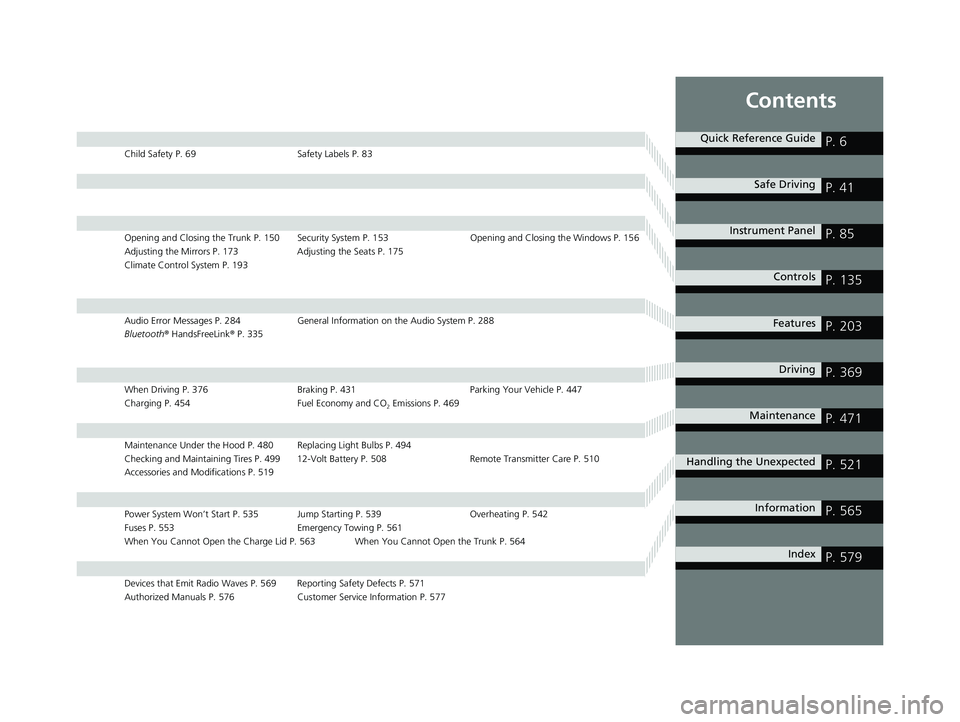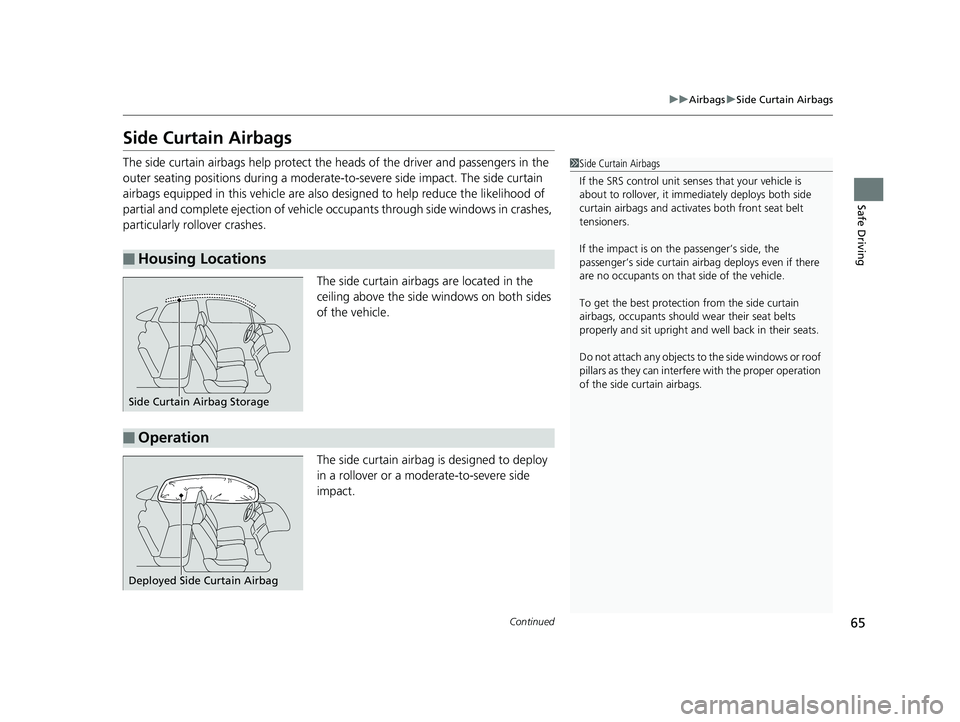Page 7 of 591

ContentsChild Safety P. 69 Safety Labels P. 83
Opening and Closing the Trunk P. 150 Security System P. 153 Opening and Closing the Windows P. 156
Adjusting the Mirrors P. 173 Adjusting the Seats P. 175
Climate Control System P. 193
Audio Error Messages P. 284 General Information on the Audio System P. 288
Bluetooth ® HandsFreeLink ® P. 335
When Driving P. 376 Braking P. 431 Parking Your Vehicle P. 447
Charging P. 454 Fuel Economy and CO 2
Emissions P. 469
Maintenance Under the Hood P. 480 Replacing Light Bulbs P. 494
Checking and Maintaining Tires P. 499 12-Volt Battery P. 508 Remote Transmitter Care P. 510
Accessories and Modifications P. 519
Power System Won’t Start P. 535 Jump Starting P. 539 Overheating P. 542
Fuses P. 553 Emergency Towing P. 561
When You Cannot Open the Charge Lid P. 563 When You Cannot Open the Trunk P. 564
Devices that Emit Radio Waves P. 569 Reporting Safety Defects P. 571
Authorized Manuals P. 576 Customer Service Information P. 577 Quick Reference Guide
P. 6 Safe Driving
P. 41 Instrument Panel
P. 85 Controls
P. 135 Features
P. 203 Driving
P. 369 Maintenance
P. 471 Handling the Unexpected
P. 521 Information
P. 565
Index
P. 57918 CLARITY PHEV CSS-31TRW6000.book 7 ページ 2017年8月31日 木曜日 午後2時4 9分
Page 10 of 591
Visual Index
8
Quick Reference Guide ❙ Power Window Switches (P 156)
❙ Trunk Opener (P 150)
❙ Driver’s Knee Airbag (P 61)❙ Door Mirror Controls (P 174)
❙ Power Door Lock Master Switch (P 148)
❙ Fuel Fill Door Release Button (P 452)
❙ Memory Buttons *
(P 171)
❙ SET Button *
(P 171)
❙ Interior Fuse Box (P 556)❙ Automatic Brake Hold Button (P 435)❙ Driver’s Front Airbag (P 57)
❙ Passenger’s Front Airbag (P 57)
❙ SPORT Button (P 389)
❙ Glove Box (P 185)
❙ Electric Parking Brake Switch (P 431)
❙ Shift Button
Electronic Gear Selector (P 382)
❙ Accessory Power Socket (P 189)
❙ Hood Release Handle (P 481)❙ ECON Button (P 388)
❙ HV Button (P 16)
❙ Rearview Mirror (P 173)18 CLARITY PHEV CSS-31TRW6000.book 8 ページ 2017年8月31日 木曜日 午後2時4 9分
Page 12 of 591
Visual Index
10
Quick Reference Guide ❙ Maintenance Under the Hood (P 480)
❙ Windshield Wipers (P 166, 496)
❙ Tires (P 499, 522)
❙ Door Lock/Unlock Control (P 139)
❙ Power Door Mirrors (P 174)
❙ Headlights (P 162, 494)
❙ Front Turn Signal Lights (P 161, 494)
❙ How to Refuel (P 452)
❙ High-Mount Brake Light (P 495)
❙ Emergency Trunk Release Lever (P 152)
❙ Opening/Closing the Trunk (P 150)
❙ Tail/Rear Side Marker Lights (P 495)
❙ Brake Lights (P 495)
❙ Rear Turn Signal Lights (P 495)
❙ Back-Up Lights (P 495)
❙ Taillights (P 495)
❙ Trunk Release Button (P 151)
❙ Rear License Plate Light (P 495)
❙ Multi-View Rear Camera (P 449)❙ Parking/Daytime Running Lights (P 162, 165, 494)
❙ Front Side Marker Lights (P 162, 494)
❙ How to Charge (P 455)18 CLARITY PHEV CSS-31TRW6000.book 10 ページ 2017年8月31日 木曜日 午後2時 49分
Page 37 of 591
35
Quick Reference Guide
Maintenance (P 471)
Under the Hood (P 480)
● Check engine oil, coolants and windshield washer fluid. Add
when necessary.
● Check brake fluid.
● Check the 12-volt battery condition monthly.
a Pull the hood release handle under the corner of the
dashboard.
b Locate the hood latch lever, push it to the side, and then
raise the hood. Once you have raised the hood slightly, you
can release the lever.
c When finished, close the hood and make sure it is firmly
locked in place. Lights (P 494)
● Inspect all lights regularly.Wiper Blades (P 496)
● Replace blades if they leave streaks
across the windshield.
Tires (P 499)
● Inspect tires and wheels regularly.
● Check tire pressures regularly.
● Install snow tires for winter driving.18 CLARITY PHEV CSS-31TRW6000.book 35 ページ 2017年8月31日 木曜日 午後2時 49分
Page 38 of 591
36
Quick Reference Guide Handling the Unexpected (P 521)
Flat Tire (P 522)
● Park in a safe location and repair the flat
tire using the temporary tire repair kit.
Indicators Come On (P 545)
● Identify the indicator and consult the
owner’s manual. Power System Won’t Start (P 535)
● If the 12-volt battery is dead, jump start
using a booster battery.
Blown Fuse
(P 553)
● Check for a blown fuse if an electrical
device does not operate.Overheating (P 542)
● Park in a safe location. If you do not see
steam under the hood, open the hood,
and let the power system cool down.
Emergency Towing (P 561)
● Call a professional towing service if you
need to tow your vehicle.18 CLARITY PHEV CSS-31TRW6000.book 36 ページ 2017年8月31日 木曜日 午後2時 49分
Page 59 of 591

57 uu Airbags u Types of Airbags
Continued
Safe Driving
Types of Airbags Your vehicle is equipped with four types of airbags:
• Front airbags: Airbags in front of the driver’s and front passenger’s seats.
• Driver’s knee airbag: Airbag under the steering column.
• Side airbags: Airbags in the driver’s and front passenger’s seat-backs.
• Side curtain airbags: Airbags above th e side windows.
Each is discussed in the following pages.
Front Airbags (SRS) The front SRS airbags inflate in a moderate-to-severe frontal collision to help protect
the head and chest of the driver and/or front passenger.
SRS (Supplemental Restraint System) indica tes that the airbags are designed to
supplement seat belts, not replace them . Seat belts are the occupant’s primary
restraint system.
The front airbags are housed in the center of the steering wheel for the driver, and
in the dashboard for the front pass enger. Both airbags are marked SRS AIRBAG .
■ Housing Locations 1 Types of Airbags
The airbags can inflate whenever the power mode is
in ON.
After an airbag inflates in a crash, you may see a
small amount of smoke. This is from the combustion
process of the infl ator material and is not harmful.
People with respiratory pr oblems may experience
some temporary discomfort. If this occurs, get out of
the vehicle as soon as it is safe to do so.
1 Front Airbags (SRS)
During a frontal crash severe enough to cause one or
both front airbags to deploy, the airbags can inflate
at different rates, dependi ng on the severity of the
crash, whether or not the se at belts are latched, and/
or other factors. Frontal airbags are designed to
supplement the seat belts to help reduce the
likelihood of head and chest injuries in frontal
crashes.18 CLARITY PHEV CSS-31TRW6000.book 57 ページ 2017年8月31日 木曜日 午後2時 49分
Page 62 of 591

uu Airbags u Front Airbags (SRS)
60
Safe Driving The airbags have advanced features to help reduce the likelihood of airbag related
injuries to smaller occupants.
The driver’s advanced ai rbag system includes a
seat position sensor.
Based on information from this sensor and the
severity of the impact, the advanced airbag
system determines the optimal deployment of
the driver’s airbag.
The front passenger’s ad vanced airbag system
has weight sensors.
We advise against allowing a child age 12 or
under to ride in the front passenger’s seat.
However, if you do allow a child age 12 or
under to ride in the front passenger’s
seat , note that the system will automatically
turn off the front passenger’s airbag if the
sensors detect that the child is approximately
65 lbs (29 kg) or less.■ Advanced Airbags 1 Advanced Airbags
If there is a problem with the driver’s seat position
sensor, the SRS indicator wi ll come on, and in the
event of a crash, the airbag will deploy (r egardless of
the driver’s seating position) with a force
corresponding to the se verity of the impact.
For the advanced airbags to work properly:
• Do not spill any liquid on or under the seats.
• Do not put any object under the passenger’s seat.
• Make sure any objects are positioned properly on
the floor. Improperly pos itioned objects can
interfere with the advanced airbag sensors.
• All occupants should sit upri ght and wear their seat
belts properly.
• Do not cover the passenger ’s side dashboard with
a cloth, towel, cover, etc.
2 Passenger Front Airbag Off Indicator P. 67
Make sure the floor mat behind the front passenger's
seat is hooked to the floor mat anchor. An improperly
placed mat can interfere with the advanced airbag
sensors.
2 Floor Mats P. 514Driver’s
Seat
Position
Sensor
Passenger’s
Seat
Weight
Sensors18 CLARITY PHEV CSS-31TRW6000.book 60 ページ 2017年8月31日 木曜日 午後2時 49分
Page 67 of 591

65 uu Airbags u Side Curtain Airbags
Continued
Safe Driving
Side Curtain Airbags The side curtain airbags help protect the heads of the driver and passengers in the
outer seating positions during a moderate-to -severe side impact. The side curtain
airbags equipped in this vehicle are also de signed to help reduce the likelihood of
partial and complete ejection of vehicle occupants through side windows in crashes,
particularly rollover crashes.
The side curtain airbags are located in the
ceiling above the side windows on both sides
of the vehicle.
The side curtain airbag is designed to deploy
in a rollover or a moderate-to-severe side
impact.■ Housing Locations 1 Side Curtain Airbags
If the SRS control unit sens es that your vehicle is
about to rollover, it imme diately deploy s both side
curtain airbags and activates both front seat belt
tensioners.
If the impact is on the passenger’s side, the
passenger’s side curtain airb ag deploys even if there
are no occupants on that side of the vehicle.
To get the best protecti on from the side curtain
airbags, occupants should wear their seat belts
properly and sit upr ight and well back in their seats.
Do not attach any objects to the side windows or roof
pillars as they can interfere with the proper operation
of the side curtain airbags.
Side Curtain Airbag Storage
■ Operation
Deployed Side Curtain Airbag18 CLARITY PHEV CSS-31TRW6000.book 65 ページ 2017年8月31日 木曜日 午後2時 49分